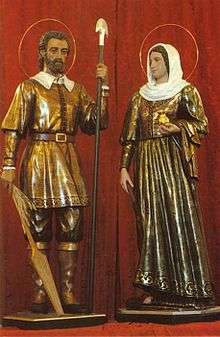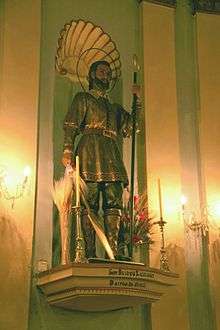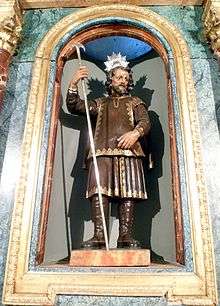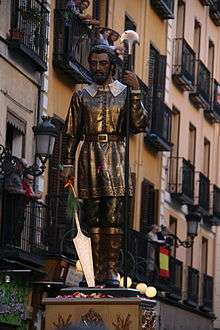Isidore the Laborer
Isidore the Farm Labourer, also known as Isidore the Farmer (Spanish: San Isidro Labrador) (c. 1070 – May 15, 1130), was a Spanish farmworker known for his piety toward the poor and animals. He is the Catholic patron saint of farmers and of Madrid, and of La Ceiba, Honduras. His feast day is celebrated on May 15.
Saint Isidore | |
|---|---|
.jpg) Saint Isidore the Farmer | |
| Confessor | |
| Born | c. 1070 Madrid, Taifa of Toledo |
| Died | May 15, 1130 (aged 59) or 1172 Madrid, Kingdom of Castile |
| Venerated in | Roman Catholic Church Anglican Communion Aglipayan Church |
| Beatified | May 2, 1619, Rome by Pope Paul V |
| Canonized | March 12, 1622, Rome by Pope Gregory XV |
| Feast | May 15;[1] October 25; March 22 |
| Attributes | Portrayed as a peasant holding a sickle and a sheaf of corn, a sickle and staff; as an angel plows for him; or with an angel and white oxen near him.[2] In Spanish art, his emblems are a spade or a plough. |
| Patronage | Madrid agriculture; farmers; day labourers; Argentina San Isidro Chile Cuz Cuz |
The Spanish profession name labrador comes from the verb labrar ("to till", "to plow" or, in a broader sense, "to work the land"). Hence, to refer to him as simply a "laborer" is a poor translation of the Spanish labrador as it makes no reference to the essential farming aspect of his work and his identity. His real name was Isidro de Merlo y Quintana.
Biography
Isidore was born in Madrid, in about the year 1070, of poor but very devout parents, and was christened Isidore from the name of their patron, St. Isidore of Seville. Isidore spent his life as a hired hand in the service of the wealthy Madrilenian landowner Juan de Vargas on a farm in the city's vicinity.[3] He shared what he had, even his meals, with the poor.[4] Juan de Vargas would later make him bailiff of his entire estate of Lower Caramanca.
Isidore married Maria Torribia, known as Santa María de la Cabeza in Spain; she has never been canonized, pending confirmation by Pope Francis. Isidore and Maria had one son.[3] On one occasion, their son fell into a deep well and, at the prayers of his parents, the water of the well is said to have risen miraculously to the level of the ground, bringing the child with it. In thanksgiving Isidore and Maria then vowed sexual abstinence and lived in separate houses. Their son later died in his youth.
Isidore died on May 15, 1130, at his birthplace close to Madrid, although the only official source places his death in the year 1172.[5]
Miracle stories

In the morning before going to work, Isidore would usually attend Mass at one of the churches in Madrid. One day, his fellow farm workers complained to their master that Isidore was always late for work in the morning. Upon investigation the master found Isidore at prayer while an angel was doing the ploughing for him.[4]
On another occasion, his master saw an angel ploughing on either side of him, so that Isidore's work was equal to that of three of his fellow field workers. Isidore is also said to have brought back to life his master's deceased daughter, and to have caused a fountain of fresh water to burst from the dry earth to quench his master's thirst.[4]
One snowy day, when going to the mill with wheat to be ground, he passed a flock of wood-pigeons scratching vainly for food on the hard surface of the frosty ground. Taking pity on the poor animals, he poured half of his sack of precious wheat upon the ground for the birds, despite the mocking of witnesses. When he reached the mill, however, the bag was full, and the wheat, when it was ground, produced double the expected amount of flour.
Isidore's wife, Maria, always kept a pot of stew on the fireplace in their humble home as Isidore would often bring home anyone who was hungry. One day he brought home more hungry people than usual. After she served many of them, Maria told him that there simply was no more stew in the pot. He insisted that she check the pot again, and she was able to spoon out enough stew to feed them all.[2]
On April 2, 1212, after torrential rains had exhumed cadavers from cemeteries in Madrid, his body was discovered in an apparent state of incorruptibility.[5]
He is said to have appeared to Alfonso VIII of Castile, and to have shown him the hidden path by which he surprised the Moors and gained the victory of Las Navas de Tolosa, in 1212.[4] When King Philip III of Spain was cured of a deadly disease after touching the relics of the saint, the king replaced the old reliquary with a costly silver one and instigated the process of his beatification.[6] Throughout history, other members of the royal family would seek curative powers from the saint.
The number of miracles attributed to him has been counted as 438.[6] The only original source of hagiography on him is a fourteenth century codex called Códice de Juan Diácono which relates five of his miracles:
- The pigeons and the grain.
- The angels ploughing.
- The saving of his donkey, through prayer, from a wolf attack.
- The account of his wife's pot of food.
- A similar account of his feeding the brotherhood.
The codex also attests to the incorruptible state of his body, stating it was exhumed 40 years after his death.[7]
Veneration

Isidore was beatified in Rome on May 2, 1619, by Pope Paul V. He was canonized nearly three years later by Pope Gregory XV, along with Saints Ignatius of Loyola, Francis Xavier, Teresa of Ávila and Philip Neri, on March 12, 1622.[8]
In 1696, his relics were moved to the Royal Alcazar of Madrid to intervene on behalf of the health of Charles II of Spain. While there, the King's locksmith pulled a tooth from the body and gave it to the monarch, who slept with it under his pillow until his death. This was not the first, nor the last time his body was allegedly mutilated out of religious fervour. For example, it was reported one of the ladies in the court of Isabella I of Castile bit off one of his toes.
In 1760, his body was brought to the Royal Palace of Madrid during the illness of Maria Amalia of Saxony.
In 1769, Charles III of Spain had the remains of Saint Isidore and his wife Maria relocated to the San Isidro Church, Madrid.[5] The sepulcher has nine locks and only the King of Spain has the master key. The opening of the sepulcher must be performed by the Archbishop of Madrid and authorized by the King himself. Consequently, it has not been opened since 1985.[9]
His feast day is celebrated on May 15 in the Catholic Church,[8] and in the Philippine Independent Church.
Patronage
Saint Isidore is widely venerated as the patron saint of farmers, peasants, day laborers and agriculture in general, as well as brick layers. His hometown of Madrid, the Spanish cities of Leon, Zaragoza, and Seville, and various locales in the former Spanish Empire honour him as their patron saint. The US National Catholic Rural Life Conference claims him as its patron.[10] San Ysidro, California, and San Ysidro, New Mexico, were named after him.
Iconography
Saint Isidore is often portrayed as a peasant holding a sickle and a sheaf of corn. He might also be shown with a sickle and staff; as an angel plows for him; or with an angel and white oxen near him.[2] In Spanish art, his emblems are a spade or a plough.
Legacy

The story of St. Isidore is a reminder of the dignity of work, and that ordinary life can lead to holiness.[10] Legends about angel helpers and mysterious oxen indicate that his work was not neglected and his duties did not go unfulfilled. St. Isidore's life demonstrates that: If you have your spiritual self in order, your earthly commitments will fall into order also."[11]
The house of his master, Juan de Vargas, in Madrid is now a museum, popularly known as the "Casa de San Isidro". It houses temporary exhibitions on the history of Madrid, as well as on the life of the saint.[12] It is not to be confused with the aforementioned San Isidro Church. Not only does this museum contain a chapel built upon the place where Isidore lived and died, but also the well where his son fell and was saved.
Feast day celebrations and festivals
The date of his liturgical feast, which, though not included in the General Roman Calendar, has been celebrated for centuries in several countries and dioceses, is May 15.[13] Many towns venerate St Isidore and his wife Saint Maria Torribia with processions in which the fields are blessed.
Spain

One of the most celebrated holidays of Madrid is held on May 15, the Feast Day of San Isidro who is the city's patron saint as well as the patron saint of farmers. The traditional festival and feast are held in an open-air area known as the Pradera del Santo. In the afternoon, the image of San Isidro and his wife, Santa Maria de la Cabeza, are paraded through the streets, from Calle del Sacramento to the Plaza de la Villa, via Calle del Cordon.[12]
The feast in honor of San Isidro is declared of National Tourist Interest in Andalusia and is one of the most important celebrations in province of Malaga. The fiesta is very popular in region of Alameda because San Isidro is a patron of the town.[14]
Celebrations honoring both saints are also held elsewhere in Spain. For years, the Alicantine locality of Castalla has been celebrating the Fair of San Isidro, where numerous companies display their products in a playful and festive atmosphere. A medieval swap meet and mechanical attractions are especially popular.
A large celebration is held in Estepona, (near Marbella) in Andalucia, where locals celebrate the day by drinking a mix of brandy and a popular energy drink which is named in his honour. This has led to St. Isidore often being termed as the patron saint of krunk (because of the name of this combination drink in the US).
The Romería festival in Almogia, a pueblo blanco in the campo north of Malaga (about halfway between Malaga and Antequera) in Andalucia, celebrates San Isidro, its patron saint, on the middle weekend of May with a fiesta carnival. Floats from the surrounding farming communities, accompanied by traditionally dressed ladies in flamenco dresses and caballeros on dancing horses, sing and dance from Almogia to the Romería ground a few kilometres north of the village and the festival includes music, traditional horse races, a bar for horses as well as their riders, and much parading of costume and finery. The best-dressed float is awarded a prize.
Chile
May 15 is San Isidro Day in Cuz-Cuz, about five kilometers from the city of Illapel, Choapa province, in the Coquimbo region of Chile. If the day falls on a Monday, the following Sunday is celebrated. Celebrations begin at noon with a Mass, followed by a procession and Chilean dances.
Peru
The residents of San Isidro de Carampá of Ayacucho in the city of Lima celebrate a San Isidro festival. The First Society of San Isidro de Carampá organizes the festival, along with the Butler and the Adornante festivals. In the evening, after the celebration of the Mass, a procession moves to the house of the Adornante. On the next day, Central Day, another Mass is said, this time celebrated by the Butler. Another procession is held, followed by a festival.
Philippines
Several festivals are held in honour of Saint Isidore on around May 15 throughout mostly agricultural and predominantly Catholic Philippines.
- The "Apit" Festival of the town of Allacapan, Cagayan, a praising and thanksgiving event in the harvest their gathered throughout the year. The Apit Festival is celebrated on dates May 10–15.
- The Sabugan ng Biyaya Festival (also known as simply Sabugan Festival) of the town of Agdangan, Quezon, is a thanksgiving event for the blessings that the town has received.
- The colourful Pahiyás Festival is held in honour of St. Isidore and María de la Cabeza in Lucban, Quezon, in thanksgiving for a bountiful harvest.
- The Kangga Festival is held on his feast day in Mogpog, Marinduque (the island province best known for its Moriones Festival every Holy Week). The festivities highlight Filipino farming traditions, as well as in thanksgiving for a good harvest and the town's continuing prosperity.
- The Bariw Festival is celebrated in Nabas, Aklan, every May 12–15 as St. Isidore is the town's patron saint. The feast also showcases the town's bariw products such as hats and mats as well as the town's unique attractions.
- Carabaos are made to kneel before the Church of San Isidro Labrador during the town fiesta of Pulilan, Bulacan.
- St Isidore is celebrated in the towns of San Isidro and Talavera, Nueva Ecija. The province is often referred to as the "Rice Granary of the Philippines", and its principal crops aside from rice are corn and onions. Celebrations begin a week before the feast itself, including daily novenas, Masses, processions, entertainment and a funfair (perya).
- The Barangay San Isidro of Lupao, Nueva Ecija also celebrated the feast day of St. Isidore, their patron saint.
- St. Isidore's feast is also celebrated in the town of Lezo, Aklan every May 14–15.
- Barangay Teguis in Poro, Cebu celebrates St. Isidore's feast on May 15, as well as the day after.
- Towns of Tubigon and San Isidro in Bohol celebrate St. Isidore's feast day on May 15.
- Sitio Canipa-an in Barangay Banquerohan, Cadiz City, Negros Occidental also celebrates the feast annually in the midst of May. Their patron saint is San Isidro Labrador. The first honour for the saint was held on 1918.
- In Pampanga, the Feast of San Isidro is celebrated every May 15 in different barangays. City of San Fernando, Bacolor, Macabebe and other towns do have barangays named after San Isidro.
- Barangay Calag-itan (St. Isidore the Farmer Chapel) and Barangay Catublian (Parish of St. Isidore the Farmer) both IFI churches and other Barangays of the town Hinunangan (rice granary of Southern Leyte) and Silago (IFI Mercedes, Silago) Southern Leyte also celebrate the feast of St. Isidore.
- Barangay Calag-itan (St. Isidore the Farmer Chapel) and Barangay Catublian (Parish of St. Isidore the Farmer) both IFI churches and other Barangays of the town Hinunangan (rice granary of Southern Leyte) and Silago (IFI Mercedes, Silago) Southern Leyte also celebrate the feast of St. Isidore.
- In Barangay Salawag in the Dasmariñas City, the Feast of San Isidro is celebrated along with the Feast of the arrival of the Virgen de Salawag. San Isidro Labrador is the Patron of the said Barangay and the Secondary Patron of the Parish Community since 1987.
United States
In 1947, at the request of the National Catholic Rural Life Conference, he was officially named patron of farmers, with a feast day on May 10 in all dioceses of the United States, with a proper Mass and Office. When St Isidore's feast was first inserted into the calendar for the United States in the year 1947, the feast day of Saint John Baptist de La Salle was still being celebrated on May 15, with the result that the celebration of his feast was assigned to March 22.
With the 1969 revision of the General Roman Calendar, the memorial of Saint John Baptist de la Salle was moved to his day of death, April 7, and Saint Isidore's was restored to the May 15 date and is celebrated as an optional memorial. In some places within the US and Canada, his feast is celebrated on October 25, and other locations and some Traditionalist Catholics in that area, though not elsewhere, keep the March 22 date.
Corrales, New Mexico
In Corrales, New Mexico, the town celebrates the San Ysidro Feast day on May 15. Matachinas dance through the streets and the fiesta is a big part of the celebrations in the city.
See also
- Saint Isidore the Laborer, patron saint archive
References
- Roman Martyrology 2001 for 21st-century date; Catholic Encyclopedia (1910) for (same) early 20th-century date
- d, d. "Isidore and Maria, Patron Saints of Farmers". d. National Catholic Rural Life Conference. Archived from the original on April 6, 2013. Retrieved April 6, 2013.
- Butler, Alban. The Lives or the Fathers, Martyrs and Other Principal Saints, Vol. V, D. & J. Sadlier, & Company, 1864
- "St. Isidore – Our Patron Saint". Archived from the original on May 22, 2013. Retrieved November 21, 2016.
- ABC (May 14, 2014). "Las idas y venidas del cuerpo incorrupto de San Isidro Labrador". Retrieved November 21, 2016.
- "Los milagros más famosos de San Isidro".
- Megías, Fdez. "Juan Diácono, el hombre "anónimo" que rescató la memoria de San Isidro". Retrieved November 21, 2016.
- "CATHOLIC ENCYCLOPEDIA: St. Isidore the Labourer". Retrieved November 21, 2016.
- ABC (May 14, 2014). "Tras los pasos de San Isidro por Madrid". Retrieved November 21, 2016.
- Media, Franciscan. "Franciscan Media". info.franciscanmedia.org. Retrieved July 27, 2020.
- Foley O.F.M., Leonard. Saint of the Day, Lives, Lessons, and Feast, (revised by Pat McCloskey O.F.M.), Franciscan Media ISBN 978-0-86716-887-7
- "San Isidro, Madrid". Retrieved November 21, 2016.
- Martyrologium Romanum (Libreria Editrice Vaticana 2001 ISBN 978-88-209-7210-3)
- "Festas de San Isidro Labrador (14-15 May) - Municipality of Alameda". Guide-Spain.com. Retrieved July 27, 2020.